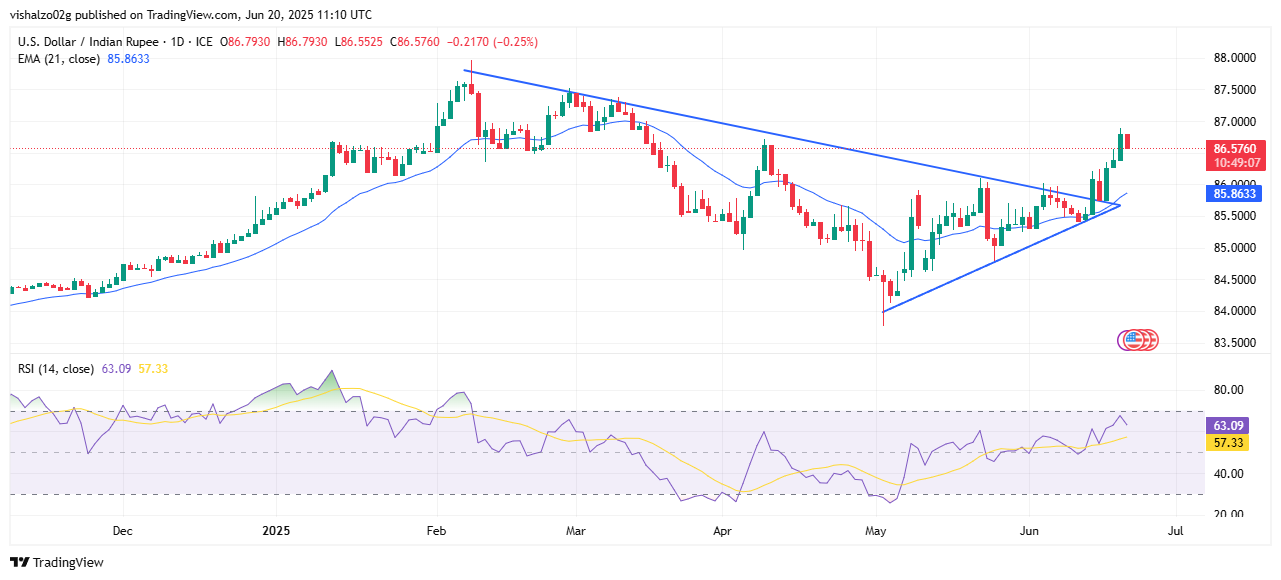Created
: 2025.06.20














![]() 2025.06.20 21:25
2025.06.20 21:25
The Indian Rupee (INR) snaps its three-day losing run against the US Dollar (USD) on Friday, recovering modestly after hitting a three-month low the previous day. A softer Greenback and a pullback in Crude Oil prices lent support to the Rupee, as traders digest US President Donald Trump's two-week delay to decide if the US will step into the Israel-Iran air conflict.
USD/INR is drifting lower during the European session, last seen trading around 86.60 at the time of writing. The pair has eased from its multi-month high but remains up over 0.50% for the week, underpinned by elevated Crude Oil prices amid the ongoing Iran-Israel conflict.
While Trump's two-week window to decide about Iran has temporarily calmed fears of an immediate escalation, risk appetite stays fragile as the conflict entered its eighth day on Friday with continued missile strikes and no clear path to de-escalation. Investors remain cautious that any miscalculation could disrupt energy flows and weigh further on emerging market currencies like the Rupee, particularly if Crude Oil prices reverse course and climb higher again.

USD/INR is showing early signs of a potential pause after a decisive breakout from a multi-month symmetrical triangle. Friday's price action is forming a bearish daily candle, highlighting that the pair is struggling to hold gains after testing the psychological 87.00 barrier.
The breakout above the triangle resistance and the 21-day Exponential Moving Average (EMA), which now sits around 85.86, confirmed a shift in near-term sentiment from neutral to bullish earlier this week. However, the pair's failure to close firmly above 87.00 has attracted profit-taking, raising the risk of a short-term pullback.
The Relative Strength Index (RSI) has cooled slightly from near overbought territory but remains comfortably above the neutral 50 level, suggesting that buyers still have control as long as the pair stays above the former triangle resistance, now acting as a support zone around 85.80-86.00.
The Indian economy has averaged a growth rate of 6.13% between 2006 and 2023, which makes it one of the fastest growing in the world. India's high growth has attracted a lot of foreign investment. This includes Foreign Direct Investment (FDI) into physical projects and Foreign Indirect Investment (FII) by foreign funds into Indian financial markets. The greater the level of investment, the higher the demand for the Rupee (INR). Fluctuations in Dollar-demand from Indian importers also impact INR.
India has to import a great deal of its Oil and gasoline so the price of Oil can have a direct impact on the Rupee. Oil is mostly traded in US Dollars (USD) on international markets so if the price of Oil rises, aggregate demand for USD increases and Indian importers have to sell more Rupees to meet that demand, which is depreciative for the Rupee.
Inflation has a complex effect on the Rupee. Ultimately it indicates an increase in money supply which reduces the Rupee's overall value. Yet if it rises above the Reserve Bank of India's (RBI) 4% target, the RBI will raise interest rates to bring it down by reducing credit. Higher interest rates, especially real rates (the difference between interest rates and inflation) strengthen the Rupee. They make India a more profitable place for international investors to park their money. A fall in inflation can be supportive of the Rupee. At the same time lower interest rates can have a depreciatory effect on the Rupee.
India has run a trade deficit for most of its recent history, indicating its imports outweigh its exports. Since the majority of international trade takes place in US Dollars, there are times - due to seasonal demand or order glut - where the high volume of imports leads to significant US Dollar- demand. During these periods the Rupee can weaken as it is heavily sold to meet the demand for Dollars. When markets experience increased volatility, the demand for US Dollars can also shoot up with a similarly negative effect on the Rupee.
![]()
Created
: 2025.06.20
![]()
Last updated
: 2025.06.20

FXStreet is a forex information website, delivering market analysis and news articles 24/7.
It features a number of articles contributed by well-known analysts, in addition to the ones by its editorial team.
Founded in 2000 by Francesc Riverola, a Spanish economist, it has grown to become a world-renowned information website.
We hope you find this article useful. Any comments or suggestions will be greatly appreciated.
We are also looking for writers with extensive experience in forex and crypto to join us.
please contact us at [email protected].
Disclaimer:
All information and content provided on this website is provided for informational purposes only and is not intended to solicit any investment. Although all efforts are made in order to ensure that the information is correct, no guarantee is provided for the accuracy of any content on this website. Any decision made shall be the responsibility of the investor and Myforex does not take any responsibility whatsoever regarding the use of any information provided herein.
The content provided on this website belongs to Myforex and, where stated, the relevant licensors. All rights are reserved by Myforex and the relevant licensors, and no content of this website, whether in full or in part, shall be copied or displayed elsewhere without the explicit written permission of the relevant copyright holder. If you wish to use any part of the content provided on this website, please ensure that you contact Myforex.
Myforex uses cookies to improve the convenience and functionality of this website. This website may include cookies not only by us but also by third parties (advertisers, log analysts, etc.) for the purpose of tracking the activities of users. Cookie policy